|
The
International Volleyball Federation and the World
Organisation Volleyball for the Disabled (WOVD)
have set the rules and regulations governing the sport.
Field
of Play
 The
playing area consists of the court and the free zone,
which together form a rectangular parallelogram. The
court is a rectangle measuring 10 x 6 metres, while the
free zone extends at least 4 metres from the long side
and 6 metres from the short side of the court. The
playing area consists of the court and the free zone,
which together form a rectangular parallelogram. The
court is a rectangle measuring 10 x 6 metres, while the
free zone extends at least 4 metres from the long side
and 6 metres from the short side of the court.
The
court is separated into two equal parts by a centre
line, each part being 5 metres long and 6 metres wide.
The net (filet), which measures 1.15 metres high for men
and 1.05 metres for women, is placed vertically along
the central dividing line. Its length varies between 6.5
and 7 metres and its width is 0.80 metres. The net is
stretched on the net post supports, where the antennas
(flexible rods, which determine the main playing area
between the two sides), are also placed and are
considered to be part of the net.
On
each of the two equal parts, and at a distance of 2
metres from the centre line, there is a parallel attack
line, which creates two zones, the attack zone
(offensive) and the back zone (defensive). The service
is performed behind the end line.
The
Game
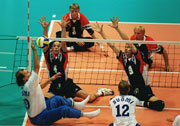 Each
team’s goal is to pass the ball over the net and
within the space set by the antennas, and to touch the
ball on the ground of the opposing team's side. Each
team is allowed to have up to three contacts with the
ball, before it returns it towards the opposing team.
The attempt at a block is not considered as a contact. Each
team’s goal is to pass the ball over the net and
within the space set by the antennas, and to touch the
ball on the ground of the opposing team's side. Each
team is allowed to have up to three contacts with the
ball, before it returns it towards the opposing team.
The attempt at a block is not considered as a contact.
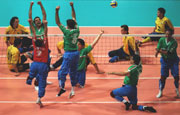 Each
game consists of a maximum of five sets. Each of the
first four sets is completed when a team wins 25 points,
with a difference of at least two points over the
opposing team (eg. 25-23). In case of a tie at 24-24,
the set continues until one of the two teams gets a lead
of two points and is declared winner of the set (eg.
26-24). In case of a 2-2 set draw, there follows a fifth
set which is completed when a team wins 15 points, again
with a difference of at least two points over the
opposing team (eg. 15-13). In the case of a 14-14 tie,
the set is continued until one of the two teams
establishes a lead of two points and is declared winner
of the set (eg. 16-14). The winning team is the one
which wins three sets. Each
game consists of a maximum of five sets. Each of the
first four sets is completed when a team wins 25 points,
with a difference of at least two points over the
opposing team (eg. 25-23). In case of a tie at 24-24,
the set continues until one of the two teams gets a lead
of two points and is declared winner of the set (eg.
26-24). In case of a 2-2 set draw, there follows a fifth
set which is completed when a team wins 15 points, again
with a difference of at least two points over the
opposing team (eg. 15-13). In the case of a 14-14 tie,
the set is continued until one of the two teams
establishes a lead of two points and is declared winner
of the set (eg. 16-14). The winning team is the one
which wins three sets.
A
team has up to 12 players, of which one is the team
leader and another the libero. The initial positions of
the players in the playing area are specific. These are
determined and controlled during the game by the
position of the pelvis in relation to the ground.
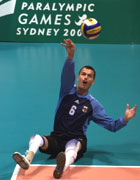 The
game begins with the service that is a hit of the ball
from the service zone at the back end of the court, with
the aim of passing the ball over the net towards the
opposing team. All action play continues until the ball
'lands' on the ground within or outside the boundaries
of the court, or when the opposing team fails to return
the ball in a regular way. When taking the service the
player's pelvis must be behind the end line, while his
or her feet or legs can be inside the court. The other
players stay in their positions. After a player performs
the service, the other players can move and take any
position in the court and the free zone. To block an
opponent’s service is permitted. The
game begins with the service that is a hit of the ball
from the service zone at the back end of the court, with
the aim of passing the ball over the net towards the
opposing team. All action play continues until the ball
'lands' on the ground within or outside the boundaries
of the court, or when the opposing team fails to return
the ball in a regular way. When taking the service the
player's pelvis must be behind the end line, while his
or her feet or legs can be inside the court. The other
players stay in their positions. After a player performs
the service, the other players can move and take any
position in the court and the free zone. To block an
opponent’s service is permitted.
Contact
of the feet or the legs with the opposing team's side of
the court is allowed, on condition that the play of the
opposing team is not obstructed. Contact with the hands
is allowed on condition that one part of the hand is
either in contact with the central line or exactly above
it.
Upon
performing an attacking hit, the pelvis of the front
zone’s player must touch the ground.
A
defense player can take attacking action that is to send
or spike the ball from whatever height behind the
attacking zone, as long as the pelvis does not touch or
pass over the attacking line. After the hit, the player
can touch the attacking zone.
Throughout
the game, the players who are involved in a defensive
effort must have contact with the ground with some part
of the body between the pelvis and the shoulders. In
certain cases of defensive action at the back end of the
court, for example while "saving the ball",
the players are allowed to lose contact with the ground
for a short time. But they are not allowed to stand up,
lift up their body or take steps.
The
game is managed by two referees, who are assisted by the
score keeper and the lines men (2 to 4, depending on the
category of the game). The two referees are placed
opposite each other, on the imaginary extension of the
court's centre line. The first referee monitors the
game, the second notes the fouls or violations in the
area of his responsibility, the score keeper has the
exclusive responsibility of noting all actions in the
score sheet, while the lines men monitor the contact of
the ball with the ground and its course inside or
outside the net's antennas. Furthermore, the lines men,
with a gesture of their hand, point out to the referee
any lifting of the pelvis that is in violation of the
rules.
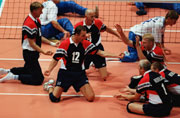 New
Rules New
Rules
Libero:
The libero is a specially trained defensive player who
wears a different coloured uniform compared to the rest
of the team. He or she has the right to enter the game
an unlimited number of times when the game is in recess
and only as a defensive player, to substitute one of the
back court defense players, without the permission of
the referee being necessary. The libero is not allowed
to serve or to spike the ball over the net. But he or
she plays a vital role in receiving the service and in
the team's defense.
In
case the libero gets injured during the game, the coach
can nominate another player as libero for the rest of
the game with the referee’s permission. The original
libero cannot play again in that same match.
Also
see:  
|
























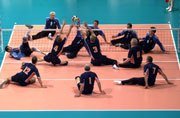 The
sport requires determination, cooperation and good strategy from
the participants. Athletes with locomotor disabilities
(amputations or other locomotor disabilities) are eligible to
participate. In Sitting Volleyball the men and women athletes
are not classified into classes as in other sports. However,
they must fulfil the conditions of a minimum degree of
disability.
The
sport requires determination, cooperation and good strategy from
the participants. Athletes with locomotor disabilities
(amputations or other locomotor disabilities) are eligible to
participate. In Sitting Volleyball the men and women athletes
are not classified into classes as in other sports. However,
they must fulfil the conditions of a minimum degree of
disability. The
playing area consists of the court and the free zone,
which together form a rectangular parallelogram. The
court is a rectangle measuring 10 x 6 metres, while the
free zone extends at least 4 metres from the long side
and 6 metres from the short side of the court.
The
playing area consists of the court and the free zone,
which together form a rectangular parallelogram. The
court is a rectangle measuring 10 x 6 metres, while the
free zone extends at least 4 metres from the long side
and 6 metres from the short side of the court. Each
team’s goal is to pass the ball over the net and
within the space set by the antennas, and to touch the
ball on the ground of the opposing team's side. Each
team is allowed to have up to three contacts with the
ball, before it returns it towards the opposing team.
The attempt at a block is not considered as a contact.
Each
team’s goal is to pass the ball over the net and
within the space set by the antennas, and to touch the
ball on the ground of the opposing team's side. Each
team is allowed to have up to three contacts with the
ball, before it returns it towards the opposing team.
The attempt at a block is not considered as a contact. Each
game consists of a maximum of five sets. Each of the
first four sets is completed when a team wins 25 points,
with a difference of at least two points over the
opposing team (eg. 25-23). In case of a tie at 24-24,
the set continues until one of the two teams gets a lead
of two points and is declared winner of the set (eg.
26-24). In case of a 2-2 set draw, there follows a fifth
set which is completed when a team wins 15 points, again
with a difference of at least two points over the
opposing team (eg. 15-13). In the case of a 14-14 tie,
the set is continued until one of the two teams
establishes a lead of two points and is declared winner
of the set (eg. 16-14). The winning team is the one
which wins three sets.
Each
game consists of a maximum of five sets. Each of the
first four sets is completed when a team wins 25 points,
with a difference of at least two points over the
opposing team (eg. 25-23). In case of a tie at 24-24,
the set continues until one of the two teams gets a lead
of two points and is declared winner of the set (eg.
26-24). In case of a 2-2 set draw, there follows a fifth
set which is completed when a team wins 15 points, again
with a difference of at least two points over the
opposing team (eg. 15-13). In the case of a 14-14 tie,
the set is continued until one of the two teams
establishes a lead of two points and is declared winner
of the set (eg. 16-14). The winning team is the one
which wins three sets. The
game begins with the service that is a hit of the ball
from the service zone at the back end of the court, with
the aim of passing the ball over the net towards the
opposing team. All action play continues until the ball
'lands' on the ground within or outside the boundaries
of the court, or when the opposing team fails to return
the ball in a regular way. When taking the service the
player's pelvis must be behind the end line, while his
or her feet or legs can be inside the court. The other
players stay in their positions. After a player performs
the service, the other players can move and take any
position in the court and the free zone. To block an
opponent’s service is permitted.
The
game begins with the service that is a hit of the ball
from the service zone at the back end of the court, with
the aim of passing the ball over the net towards the
opposing team. All action play continues until the ball
'lands' on the ground within or outside the boundaries
of the court, or when the opposing team fails to return
the ball in a regular way. When taking the service the
player's pelvis must be behind the end line, while his
or her feet or legs can be inside the court. The other
players stay in their positions. After a player performs
the service, the other players can move and take any
position in the court and the free zone. To block an
opponent’s service is permitted. New
Rules
New
Rules The
uniform of the player consists of a shirt, socks and
sports shoes. Instead of shorts, players are allowed to
wear long trousers. The players of each team must wear
shirts of the same colour. The players' shirts are
numbered from 1 to 18. The shirt of each player must
bear the players number, with letters measuring 15
centimetres in height on the front side and 20
centimetres on the back. The team leader's shirt must
bear an 8 centimetre long and 2 centimetre wide stripe,
placed under the number on the front side. The colour
and design of the uniform is identical for all the
players of the same team, apart from the
The
uniform of the player consists of a shirt, socks and
sports shoes. Instead of shorts, players are allowed to
wear long trousers. The players of each team must wear
shirts of the same colour. The players' shirts are
numbered from 1 to 18. The shirt of each player must
bear the players number, with letters measuring 15
centimetres in height on the front side and 20
centimetres on the back. The team leader's shirt must
bear an 8 centimetre long and 2 centimetre wide stripe,
placed under the number on the front side. The colour
and design of the uniform is identical for all the
players of the same team, apart from the 



